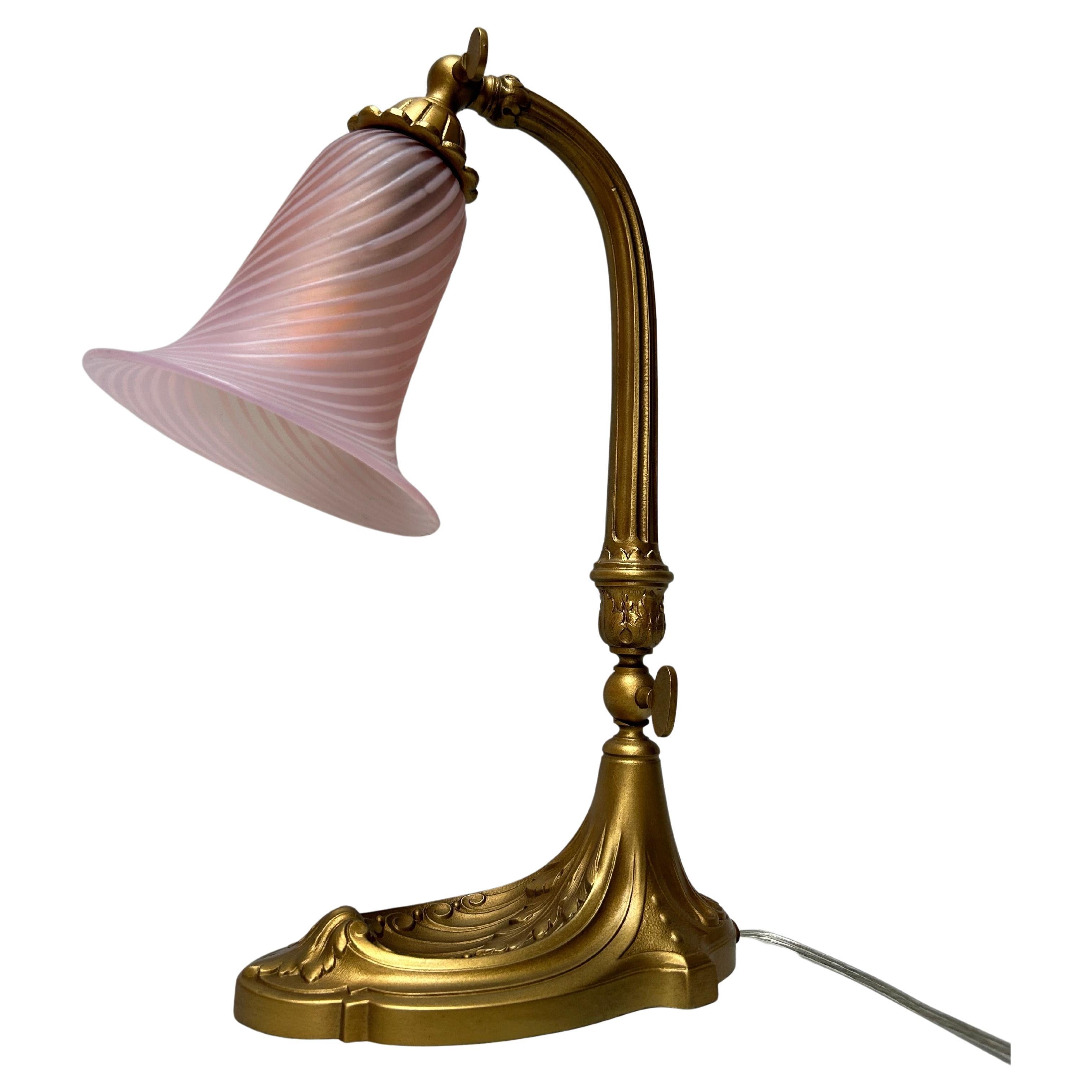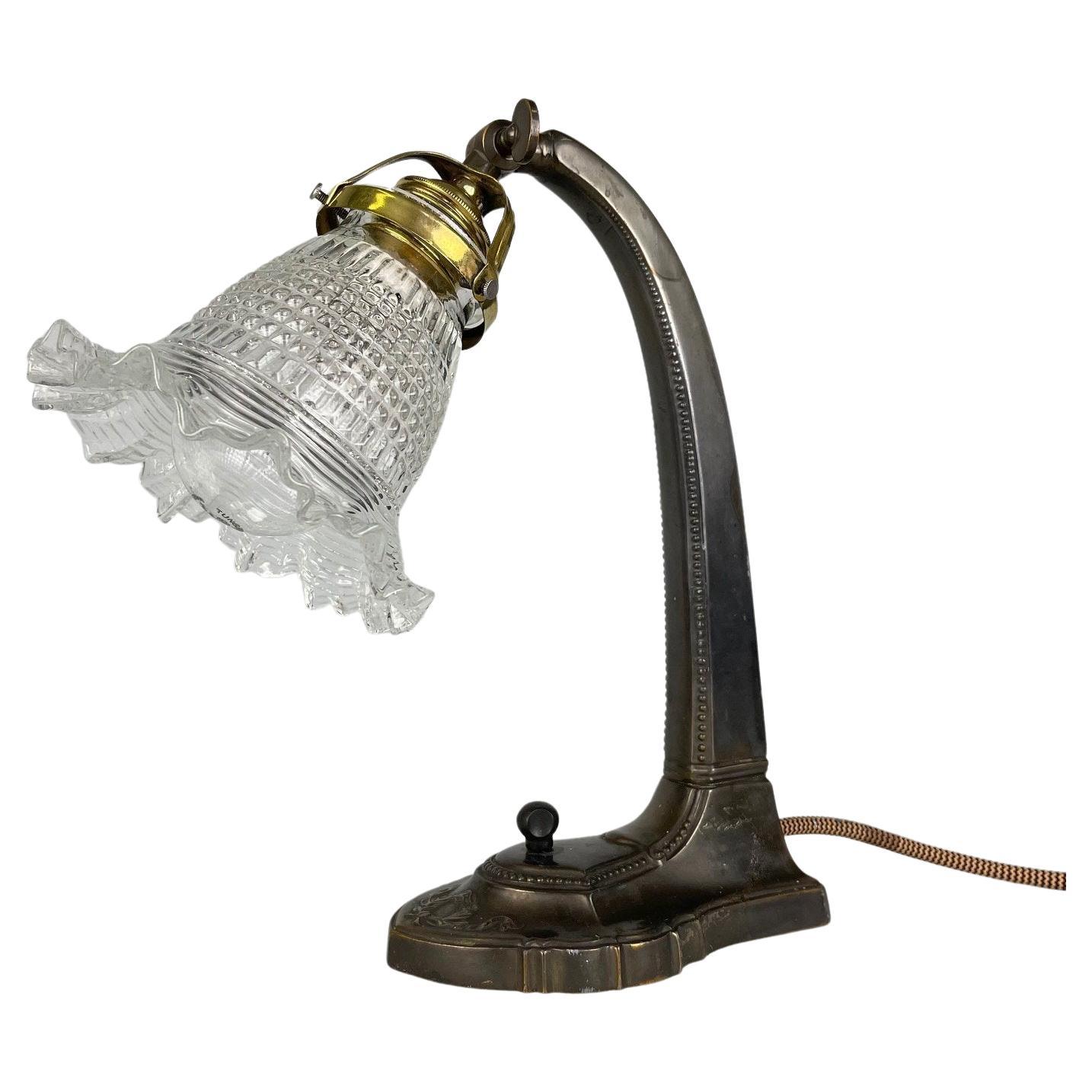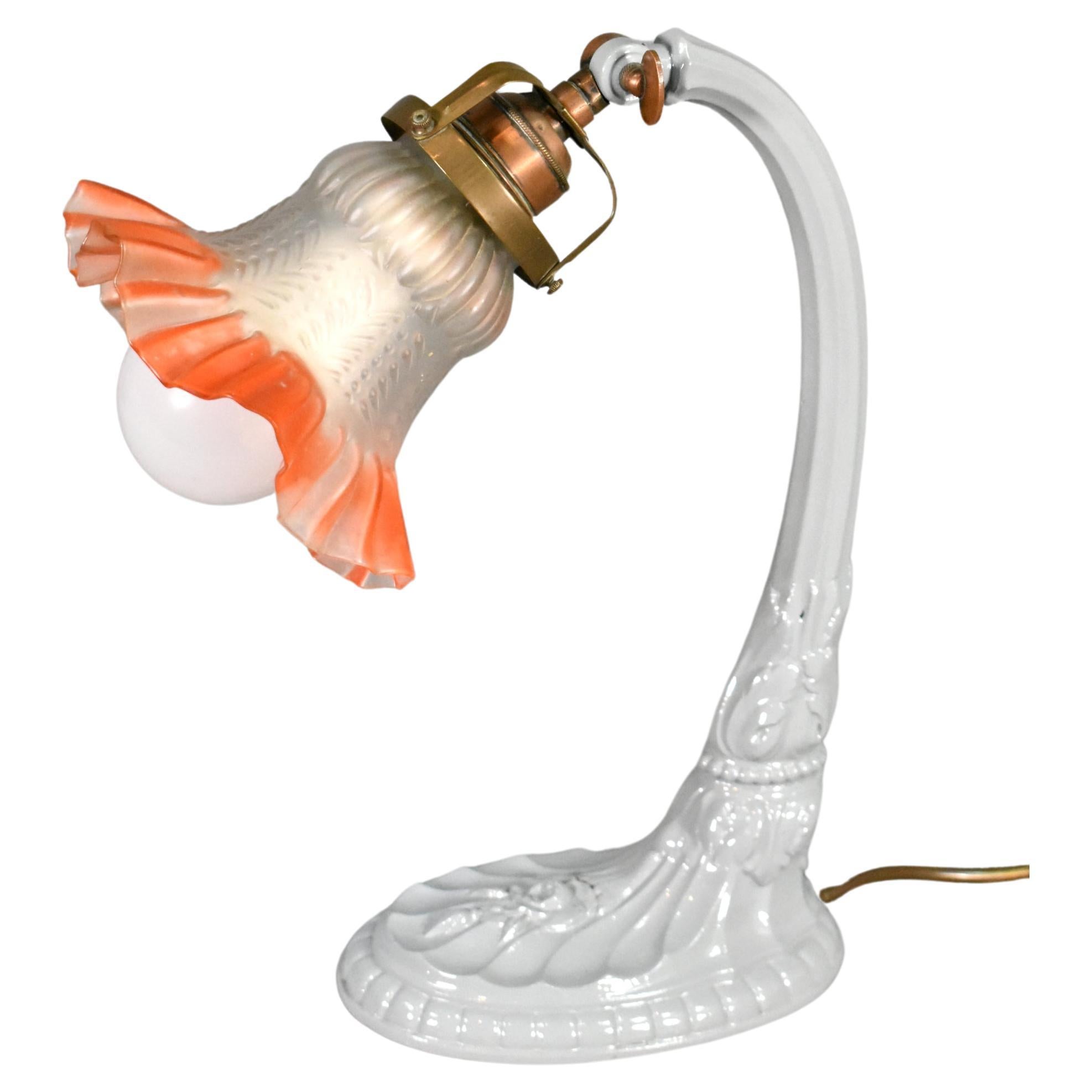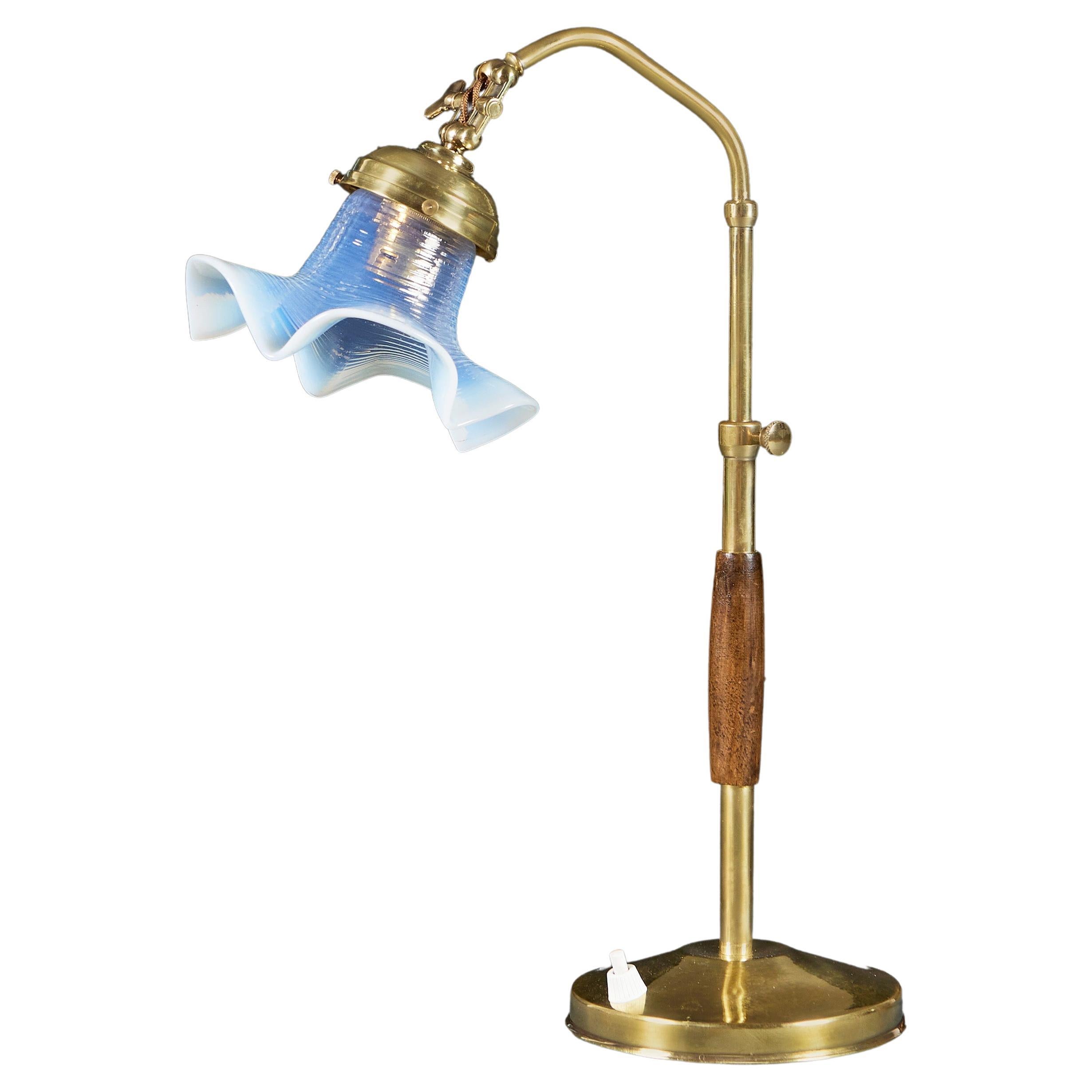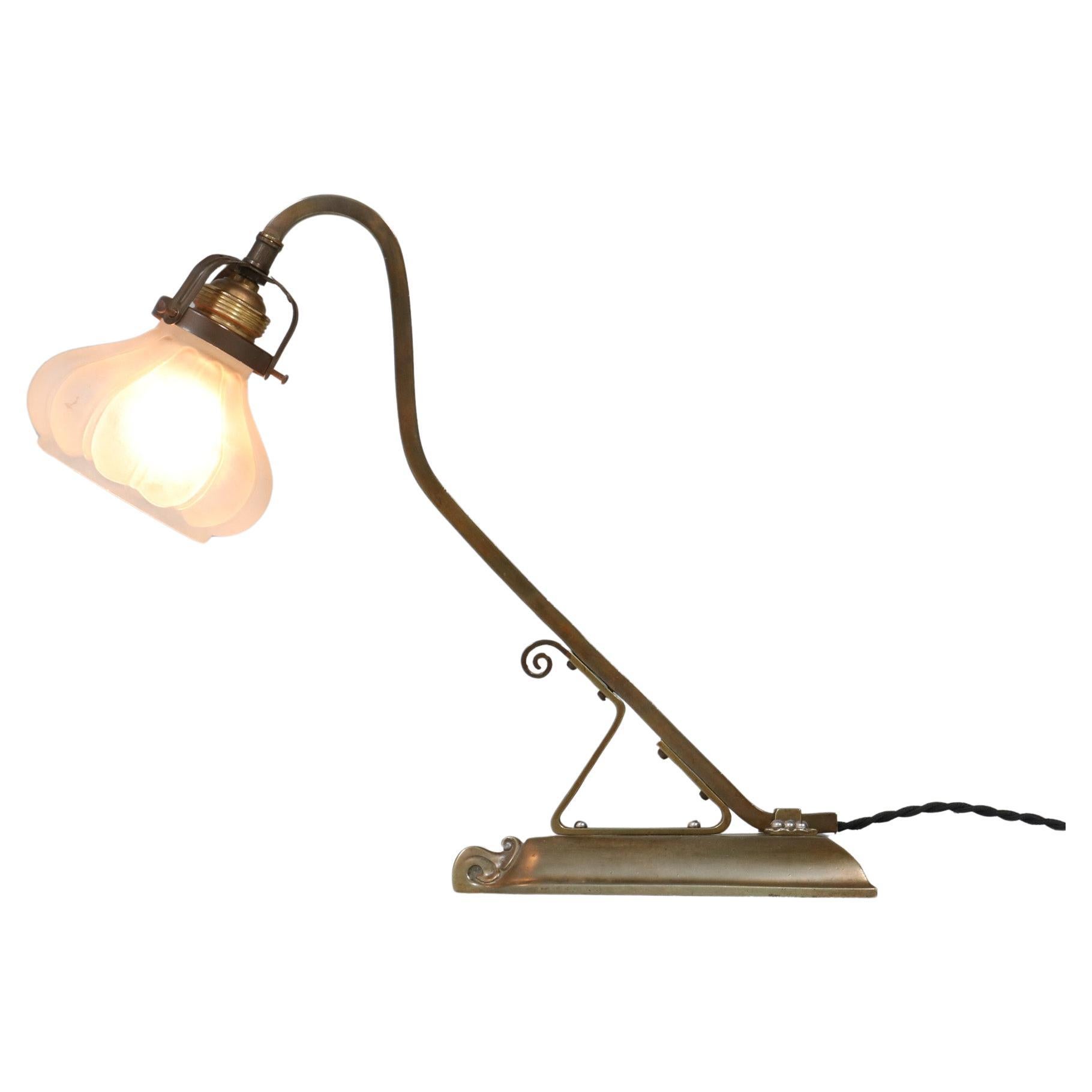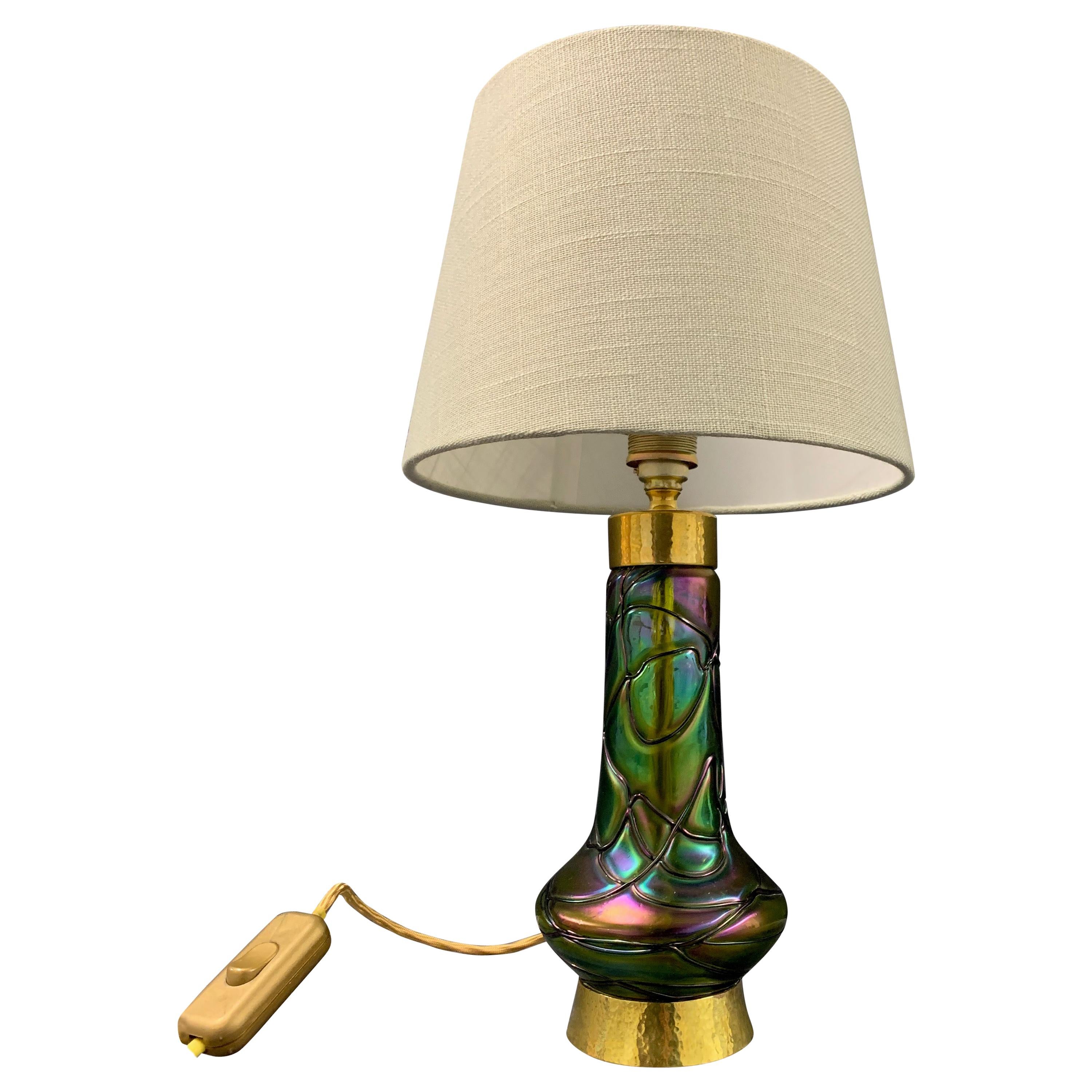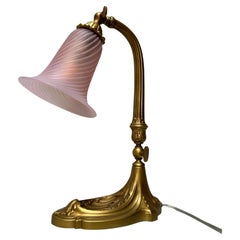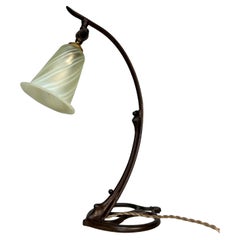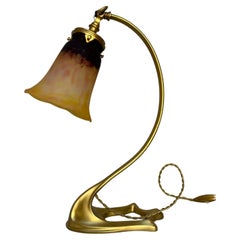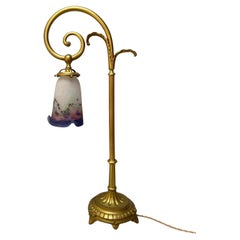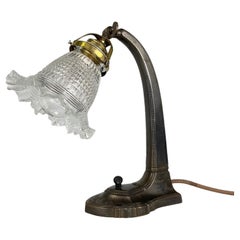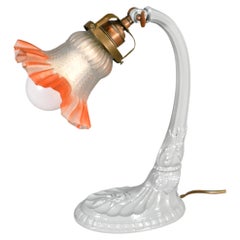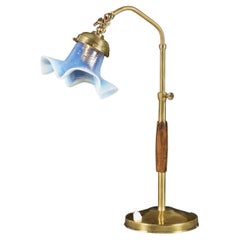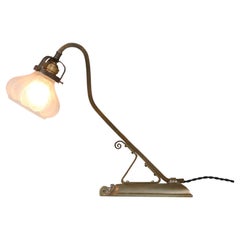Video Loading
Want more images or videos?
Request additional images or videos from the seller
1 of 11
Quezal Art Nouveau Lamp
$3,345.03
£2,439.35
€2,800
CA$4,575.94
A$5,120.60
CHF 2,673.74
MX$62,952.50
NOK 33,732.30
SEK 31,741.93
DKK 21,307.95
Shipping
Retrieving quote...The 1stDibs Promise:
Authenticity Guarantee,
Money-Back Guarantee,
24-Hour Cancellation
About the Item
Art nouveau lamp circa 1910.
Brass and copper base.
Iridescent glass tulip signed Quezal.
In perfect condition and electrified.
Total height: 38.5 cm
Base diameter: 15.5 cm
Width: 30 cm
Quezal Art Glass
Quezal Art Glass – The Journal of Antiques and Collectibles – April 2003
By Malcolm Mac Neil
Some of the most beautiful and alluring art glass made in America during the early part of the 20th Century was made by the Quezal Art Glass and Decorating Company. Often in the shape of blossoming lilies with brilliant gold interiors and colorfully decorated with floral and other motifs inspired by nature, Quezal art glass ranks right alongside the iridescent glass of Louis Comfort Tiffany and Frederick Carder. Quezal artisans created an extensive range of decorative and useful items, including vases, compotes, finger bowls, open salts, candle holders, and shades for lighting fixtures, which are equivalent in terms of beauty and quality of craftsmanship to Tiffany’s Favrile and Carder’s Aurene glass. In recent years, glass collectors have discovered anew the special charms and appeal of Quezal art glass, and collector desirability for this lovely glassware has increased dramatically.
The Quezal Art Glass and Decorating Company was incorporated a century ago, on March 27, 1902. It was founded by Martin Bach, Sr., Thomas Johnson, Nicholas Bach, Lena Scholtz, and Adolph Demuth. The factory was located on the corner of Fresh Pond Road and Metropolitan Avenue in Maspeth, Queens, New York. In October 1902, the trademark “Quezal” was successfully registered. By 1904, roughly fifty glassworkers were employed at the works.
Martin Bach, Sr. was the president, proprietor, and guiding force behind this successful company. Born in 1862 in Alsace-Lorraine to German parents, he emigrated to the United States in 1891. Before his emigration, Bach worked in Saint-Louis, France, at the Saint-Louis Glass Factory. After Bach arrived in this country, he was hired by Louis C. Tiffany as the latter’s first batch-mixer or chemist at the newly established Tiffany Glass and Decorating Company, in Corona, Queens. After a period of about eight years, Bach left Tiffany and established his own glassworks. By this time, Bach had already started his small family. He and his German-born wife, Anne-Marie Geisser, whom he married in the fall of 1889, in Paris, France, had three children. Two daughters, Jennie and Louise, were born in France and a son, Martin, Jr., was born in Corona.
Bach was assisted by Thomas Johnson, an English immigrant, and Maurice Kelly, a native of Corona, both of whom were gaffers or master glassblowers. Johnson and Kelly helped pave the way for Quezal’s early accomplishments and later recognition. Thomas Johnson, like Bach, was a founding member and also previously employed by Louis C. Tiffany. Johnson’s association with Quezal, however, was relatively short lived. Around 1907, Johnson left for Somerville, Massachusetts, where he became involved in making Kew Blas glass, under William S. Blake at the Union Glass Company. Maurice Kelly’s tenure with Quezal was also brief. Kelly worked at Quezal from January 1902 until July 1904, but by November 1904, he was making Favrile glass at Tiffany Furnaces, where he would happily remain until 1918.
To this day, the belief still exists that there once existed a man named Quezal, who worked for Louis C. Tiffany, and it is after him that Quezal glass is named. In truth, however, the founders of the Quezal Art Glass and Decorating Company named the company and its products after one of the world’s most beautiful birds, the elusive and rare quetzal, which dwells in the treetops of the remote tropical forests of Central America. A rare company promotional brochure provides a vivid description of the quetzal: Of all the birds of the America’s, it is the most gorgeous. No more splendid sight is to be seen in all the world than a quezal, flying like a darting flame through the depths of a Central American forest. Its back is of a brilliant metallic green, so vivid it shines even in the twilight of the woods like a great emerald and its breast is a crimson so deep and bright that every motion of the wonderful creature is a flashing of rubies among the trees and giant creepers. It bears a true golden crown upon its head – a helmet of bright yellow and green, shaped just as the helmet of old Aztec kings were shaped. Its tail is composed of lacelike plumes, extending more than two and one-half feet beyond its body.
The quezal was certainly an appropriate designation for the company’s resplendent glassware. One of the most prized characteristics of Quezal art glass is the shimmering and dazzling brilliance reflected in the iridescent surfaces on the interior as well as exterior of the glass. The radiant rainbow colors in metallic hues, including gold, purple, blue, green, and pink, to name only a few, were certainly inspired by the quetzal and its feathers. Not surprisingly, lustrous feathers, in shades of opal, gold, emerald, and blue, are among the most common decorative motifs encountered on Quezal glass.
The enduring hallmark of Quezal art glass is its unique expression of the Art Nouveau style, based on organic shapes and naturalistic motifs coupled with technical perfection in the execution. Vases, compotes, drinking vessels, and shades for lighting fixtures were often fashioned to resemble flowers such as crocuses, tulips, calla lilies, casablanca lilies, and jack-in-the-pulpits. Variously colored inlaid threads of glass, pulled and twisted by hooks, simulate naturalistic floral and leaf patterns, lily pads, clover leafs, and vines. Opal, gold, and green colors prevail and the glass is generally opaque. Red is the rarest color of all. Compared with Tiffany’s Favrile glass, the crisp, vivid, and colorful decoration of Quezal art glass is distinctively precise, symmetrical, and restrained.
Other Quezal wares recall shapes and styles favored in ancient Egypt, Persia, Greece, and Rome, as well as the Italian Renaissance and the Georgian period in England. This is especially true of classic-shaped vases and bowls of translucent amber glass, which have a single surface color such as iridescent gold or blue. Still, others were inspired by traditional Chinese and Japanese forms.
The Gorham Manufacturing Company in Providence, Rhode Island, and the Alvin Silver Manufacturing Company in Sag Harbor, Long Island, purchased Quezal art glass, which they in turn embellished in their shops with silver overlay decoration in the fashionable Art Nouveau style and later resold. Gorham’s silver overlay designs mostly include stylized floral motifs. Alvin’s silver designs are wonderfully organic. One sumptuous design is of a group of sinuous iris blossoms with carefully articulated petals surrounded by attenuated meandering vines. Collectors should note that not all silver-deposit pieces are marked with a maker’s mark since the silversmith had to be quite careful not to damage the glass underneath.
A rare 1907 retail catalog survives from Bailey, Banks, and Biddle Company, a luxury goods retailer in Philadelphia, which reveals original retail prices of Quezal art glass. A surprising revelation provided by this catalog is that Quezal art glass was nearly twice as expensive as comparable French imported glass made by such renowned firms as Gallé and Daum. Hock glasses, a stemmed glass used primarily for drinking German white wine, were sold by the dozen and retailed between $50 and $75. Fingerbowls were also sold by the dozen and retailed between $50 and $100. These high retail prices were nearly the same as those charged for Tiffany’s Favrile glass, and suggest Quezal art glass was also marketed towards the high-end or luxury market.
Electricity was a brand new invention in the late 1800s and American glass manufacturers developed novel approaches for concealing the electric light bulb, which was rather harsh to the eye and perhaps unflattering to the domestic interior. Tiffany, Steuben, and Quezal responded to this need with the most extraordinary and beautiful art-glass shades, all of which were hand-made and exquisitely fashioned. Many other companies also made art glass shades for table and floor lamps, electroliers, hallway fixtures, and wall sconces, but it was Quezal that excelled in this area and was the most prolific.
Quezal art glass shades were available in an infinite variety of shapes, sizes, colors, and decorations. Some shades are formed and decorated as lilies while others are bell-shaped and have ribbed or textured decoration. Rims are usually plain but sometimes are notched or ruffled. Common motifs include feather or hooked feather, leaf and vine, applied flowers, drape, fishnet, King Tut, and spider webbing. The workmanship shown on most Quezal shades is of the highest caliber. The sale of these shades represented a significant portion of the firm’s revenue. Many manufacturers and retailers of electric lighting fixtures purchased Quezal shades to sell with their fixtures, including Edward F. Caldwell and Company in New York City, Stuart-Howland Company in Boston, and The David J. Braun Mfg. Co., in Chicago. The 1907 Bailey, Banks and Biddle retail catalog mentioned earlier, reveals Quezal art glass shades retailed between $7.50 and $22.50 per shade. Today, Quezal shades are actively collected and prices are considerably higher, especially for the rarest, largest, and most elaborately decorated ones.
Amazingly, little is known about the original names for each of the company’s products – for they certainly had them. One most satisfying exception is an attractive and distinctive line introduced by Quezal in 1917, which was appropriately named “The Glass That Looks Like Pottery.” The subtle color blending and soft finish of the glass has all the rich color tones of the finest contemporary art pottery produced in America or abroad. In 1919, Quezal’s new sales representatives, Dela Croix & Wilcken, who were located at 19 Madison Avenue in Manhattan, changed the name to “Innovation.”
“Innovation” is distinguished from Quezal’s other art glass because it is not iridescent. In addition, the high-gloss body of the glass is always opaque and usually consists of a subtle and artistic blending of colors that include dark and light brown, olive green, gray, pale blue, lavender, dark orange, and pale yellow. Previously this glass has been referred to as “stone,” “agate” or “laminated” glass, which are the different terms used to designate a similar type of glass by the Tiffany Glass and Decorating Company. No two pieces are alike. The over-all effect is otherworldly and sometimes reminiscent of a tropical sunset. In some cases, the shape and coloring are strikingly similar to ceramics; in others the decoration is bold and distinctive.
Fortunately, a few of the line drawing sketchbooks, trade catalog pages, bill-heads, correspondence and other papers from the Quezal glassworks have survived. In 1994, these papers were donated by the children of Martin Bach, Jr., Gladyce Bach Wells, and Clifford Bach, to the Museum of American Glass at Wheaton Village in Millville, New Jersey. One of these documents reveals the original pattern designations, which included diamond, curl, hammered, frill, block-a-dot, reed, feather, leaf, heart, and spider. The “spider” decoration is certainly an appropriate designation for this type of glass. It is easily recognizable by the very thin threads of amber glass randomly wrapped around some vases and shades, much like a real spider would weave its web. Detailed line drawings exist for a wide variety of items and demonstrate the high level of technical skill required by Quezal artisans, who manufactured these items according to clearly prescribed specifications.
Most companies that produced art glass in this country followed the lead of Louis C. Tiffany and marked their products with an identifying signature or a paper label to distinguish their products from those of their competitors. The Quezal glassworks was no exception. Quezal art glass is usually signed so it can be more easily distinguished from similar items, including those marked Tiffany, Steuben, Kew Blas, Imperial, Fostoria, Lustre Art, and Durand. A few of the different marks that are sometimes found on genuine Quezal items include “Quezal N.Y.,” “Quezal,” accompanied by a decorative scroll underline, and “Quezal” together with a prefix letter and numeral. Two variations of the mark, “Quezal,” by itself, are known: it appears either engraved into the surface of the glass or else a special pencil or stylus was used, which left a platinum or silver signature. Vases and other tableware items are generally signed on the underside in the area of the pontil mark. The signature on a Quezal shade is usually found along the interior of the fitter rim, which is the part of the shade that adheres to the lighting fixture.
Martin Bach, Sr. was often given to generous actions and gave away a good many pieces of his beautiful Quezal glass to neighbors, friends, and even settled his local debts with his wares. When he died of cancer on August 1, 1921, at the age of fifty-nine in the Greenpoint Hospital in Brooklyn, unfilled orders for Quezal art glass totaled some $350,000 – a considerable sum in 1921. Complicating matters, Quezal was experiencing financial difficulties under the management of Robert Robinson, president, and Martin Bach, Jr., vice-president.
Dr. John Ferguson, a close friend of the Bach family and their family physician, was brought in as an investor. Dr. Ferguson, together with three other wealthy friends, raised the capital necessary to keep the factory operational. The investors contributed an undisclosed sum of money and promised additional financing if Martin Bach Jr. could show a profit of $1,000 at the end of the year.
Notwithstanding the infusion of capital, in December 1923, the Quezal Art Glass and Decorating Company was sold to Edward Conlan, a personal friend of Dr. Ferguson, and in January 1924, the Quezal Art Glass and Decorating Company was reorganized as the Quezal Glass Manufacturing Company. Dr. Ferguson served as president and Martin Bach Jr. served as general manager. The reorganized company continued to make both commercial and artistic glassware and even introduced many new articles.
Several important glass artisans were employed in the art glass shop, including Harry and Percy Britton, William Wiedebine, and Emil Larson, a gaffer hired in 1923. Sadly, by early 1924, the majority, if not all, of Quezal’s artisans from the art glass shop had left the factory, which closed soon thereafter. These individuals and Martin Bach, Jr., who was in possession of his father’s glassmaking formulas, moved on to other glass manufacturers, including the Imperial Glass Company in Bellaire, Ohio, and the Durand Art Glass division of the Vineland Flint Glass Works, in Vineland, New Jersey.
Recently, an interesting discovery was made involving Dr. Ferguson, Quezal’s last president. Amazingly, his rather sizeable collection of Quezal art glass had remained largely intact after all these many years. Dr. Ferguson was in a unique position to assemble this collection through his involvement as an investor and president of the company as well his friendship with and role as physician of the Bach family. In addition, after the company closed in 1924, he was able to bring home many of the items that still remained unsold in the company’s showroom. Following Dr. Ferguson’s retirement from his medical practice in 1949, he moved in with his niece and her husband, in Wyckoff, New Jersey, where he resided until his death in 1955. Some of the items were packed away into boxes for basement storage while others served as room decorations for the daily enjoyment of everyone in the household.
Mostly dating between 1921 and 1924, his collection comprises more than sixty individual pieces. Among the items are numerous vases with coiled, heart and vine, spider, and Egyptian-inspired decoration. There is a magnificent pair of tall, opal bud vases with elegant green leaf decoration, banded in gold. Another special item is a lightly iridized dark blue bowl with a crimped rim and applied trumpet-shaped foot, decorated with ten diagonal opal stripes. Also discovered was a large cased bowl in amber and opal decorated with an intricate interlace or fishnet design. A variety of bon-bon and nut dishes, candleholders, a tall jack-in-the-pulpit vase with a lovely chain of hearts motif on the back, and numerous matched sets of shades in various styles and decorations, complete the collection.
The Quezal Art Glass and Decorating Company was an important contributor to American Art Nouveau glass. The artistic creations of Quezal artisans are among the finest and most beautiful ever produced and remain an important and enduring legacy to the art of glass. Today’s astute collectors increasingly recognize and appreciate the resplendent glass created by these skilled artisans almost a century ago.
- Creator:Quezal (Manufacturer)
- Dimensions:Height: 15.16 in (38.5 cm)Diameter: 6.11 in (15.5 cm)
- Power Source:Plug-in
- Voltage:110-150v,220-240v
- Lampshade:Included
- Style:Art Nouveau (Of the Period)
- Materials and Techniques:
- Place of Origin:
- Period:1910-1919
- Date of Manufacture:1910
- Condition:
- Seller Location:NANTES, FR
- Reference Number:1stDibs: LU7403240461402
About the Seller
No Reviews Yet
Vetted Professional Seller
Every seller passes strict standards for authenticity and reliability
1stDibs seller since 2022
44 sales on 1stDibs
Typical response time: 7 hours
- ShippingRetrieving quote...Shipping from: NANTES, France
- Return Policy
Authenticity Guarantee
In the unlikely event there’s an issue with an item’s authenticity, contact us within 1 year for a full refund. DetailsMoney-Back Guarantee
If your item is not as described, is damaged in transit, or does not arrive, contact us within 7 days for a full refund. Details24-Hour Cancellation
You have a 24-hour grace period in which to reconsider your purchase, with no questions asked.Vetted Professional Sellers
Our world-class sellers must adhere to strict standards for service and quality, maintaining the integrity of our listings.Price-Match Guarantee
If you find that a seller listed the same item for a lower price elsewhere, we’ll match it.Trusted Global Delivery
Our best-in-class carrier network provides specialized shipping options worldwide, including custom delivery.More From This Seller
View AllArt Nouveau Desk Lamp
Located in NANTES, FR
Desk lamp in gilded spelter circa 1910. Tulip tilt adjustment possible.
Tulip in opalescent glass.
Electrified, B22 socket.
in perfect condition.
Height: 34 cm
Width: 25 cm
Depth: 1...
Category
Early 20th Century French Art Nouveau Table Lamps
Materials
Spelter
$1,433
Art Nouveau Lamp Base Model Hearts
Located in NANTES, FR
Art nouveau lamp circa 1910.
Bronze and brown patinated brass base, heart model.
Uraline tulip in opalescent glass.
The lamp is fully electrified and in ...
Category
Vintage 1910s French Art Nouveau Table Lamps
Materials
Brass, Bronze
Daum Nancy Art Nouveau Lamp Probably by Majorelle
By Louis Majorelle, Daum
Located in NANTES, FR
Art nouveau lamp circa 1900.
Gilt bronze base probably by Louis Majorelle.
Glass paste tulip signed Daum Nancy.
In perfect condition.
Electrified, B22 socket, bayonet bulb.
Height: ...
Category
Early 20th Century French Art Nouveau Table Lamps
Materials
Bronze
Muller Frères Luneville Art Nouveau period lamp
By Muller Fres Luneville
Located in NANTES, FR
Large gilded bronze lamp from the early 20th century, Art Nouveau period.
Glass paste tulip by Muller Frères.
In perfect condition, electrified, E14 socket.
Height: 61.5 cm
Base dia...
Category
Early 20th Century French Art Nouveau Table Lamps
Materials
Bronze
Art Nouveau Lamp by Victor Saglier and Daum Nancy
By Victor Saglier, Daum
Located in NANTES, FR
Gilt bronze lamp around 1900, probably by Majorelle executed by Victor Saglier. Stamped on the foot VS.
Glass paste tulip signed Daum Nancy.
Lamp electrified and in perfect condition.
Total height: 38.5 cm - 15.15 in
width: 15cm
depth: 13cm
weight: 2.3kg
Victor Saglier (1809 - 1894)
Victor Saglier is a ceramist and goldsmith known in particular for his creations in the Art Nouveau style of the late 19th century.
He produces, among other things, objects in enamelled glass, gilded metal and numerous pieces of silverware.
On his death, the company was bought by his brothers who continued production until 1948.
Victor Saglier's objects are signed by the "VS" brand.
Known for his Art Nouveau work, Saglier made several pieces for Louis Majorelle, Daum and Émile Gallé. Its style is typically French Art Nouveau in the language of the École de Nancy. He often drew inspiration from nature for his work, the logic of which helped design both forms and settings. The sign of master goldsmith Victor Saglier is an oval-shaped three-master sailboat surrounded by the letters V and S in a rectangle.
Saglier made everyday objects such as glass vases, bowls and pitchers with metal mounts, planters, tea and coffee services and candlesticks in bronze or silver-yellow metal or cast zinc.
On his death, the Victor Saglier company at 12 rue d'Enghien in Paris became Saglier Frères. It was run by his brothers Eugène and André until his death in 1948.
Daum (French establishment created in 1878) is a glass and crystal workshop located in Nancy. Founded by the industrialist and notary Jean Daum, the workshop was then taken over by his sons Auguste and Antonin, who ran it during the Art Nouveau period.
It was not until the Universal Exhibition of 1900 that the company was at the forefront of the decorative art scene, when Daum received the prestigious Grand Prix medal. At this time, Daum glass became more complex, acid treatment was often used in the cutting, enameling and etching of a piece to produce glass masterpieces. Daum also produces applied glass elements, such as handles and ornamental motifs in naturalistic shapes. The Daum brothers quickly became big names in Art Nouveau, rivaling the famous designer Émile Gallé, and established themselves as leaders in the field of decorative glass after his death.
In 1906, Daum revived glass paste, a process by which glass is transformed into paste, then it is applied to the surface of a mold and fired. This technique originates from ancient Egypt. Today, Daum is the only industrial crystal manufacturer that uses the glass paste process for its glass objects and crystal sculptures.
Following the First World War, Paul Daum began to develop works in the Art Deco style, moving away from naturalistic forms and turning to linear, angular, simplified forms and geometric patterns characteristic of the movement. After the Second World War, Henri and Michel Daum became interested in the transparency of glass and pure lines. Daum collaborates with a large number of famous artists, such as Louis Majorelle, Salvador Dalí, Hilton Mac Connico, Elizabeth Garouste and Mattia Bonetti to create glass paste objects.
Category
20th Century French Art Nouveau Table Lamps
Materials
Bronze
Art Nouveau Lamp Stamped Les Etains de France
Located in NANTES, FR
Flower lamp circa 1900.
Pewter base topped with an opalescent uraline tulip.
Electrified and in perfect condition.
Stamped Les Etains De France.
Total height: 35 cm
Pedestal diamete...
Category
Early 20th Century French Art Nouveau Table Lamps
Materials
Pewter
You May Also Like
Art Nouveau Table Lamp, 1910's
Located in Praha, CZ
Beautiful antique Art Nouveau lamp made of copper alloy, patinated to old bronze. Produced in former Czechoslovakia in the very beginning of 2...
Category
Early 20th Century Czech Art Nouveau Table Lamps
Materials
Metal
French Art Nouveau Desk Lamp
Located in SAINTE-COLOMBE, FR
French Art Nouveau Desk Lamp
A beautiful and elegant swan-shaped desk lamp, featuring flowers and leaves, which are classic motifs from the Ar...
Category
Early 20th Century French Art Nouveau Table Lamps
Materials
Brass, Copper, Spelter
An Art Nouveau Desk Lamp
Located in London, GB
France, circa 1920
An unusual early twentieth century brass art nouveau desk lamp, with adjustable stem and head, with wooden carrying handle and retaining the original undulating o...
Category
Early 20th Century French Art Nouveau Table Lamps
Materials
Brass
$2,657
Art Nouveau Table Lamp or Desk Lamp, 1900s
Located in Amsterdam, NL
Stunning and rare Art Nouveau table lamp or desk lamp.
Striking Dutch design from the 1900s.
Patinated brass frame with original hand-blown glass shade.
Rewired with one original soc...
Category
Antique Early 1900s Dutch Art Nouveau Table Lamps
Materials
Brass
$645 Sale Price
20% Off
Amazing Art Nouveau Table Lamp
By Loetz Glass
Located in Munich, DE
Attributed to loetz. New wiring and lamp socket.
Category
Antique Early 1900s Austrian Art Nouveau Table Lamps
Materials
Blown Glass
German Art Nouveau Brass Table Lamp
Located in Vienna, AT
Brass lamp base bronze plated with a hand-cut glass shade and fitted with one porcelain E27 sockets with a rotary switch. Made in Germany about 1900.
Category
Antique Early 1900s German Art Nouveau Table Lamps
Materials
Brass, Zinc
More Ways To Browse
Art Nouveau Opal
Antique Heart Shaped Box
Antique Agate Box
Italian Made Wide Diamond Bands
Tiffany Art Glass Bowl
Flying Birds Wall
Aztec Gold
Tiffany 2003
Large Ruby Heart
Three Leaf Clover
Heart Gold Hammered
Tiffany Hammer
Ruby Lustre
Gold Card Holder
Neil Diamond
Articulated Charms
Tiffany Money Box
Aztec Stone
